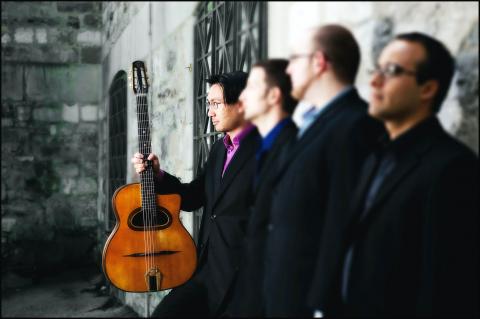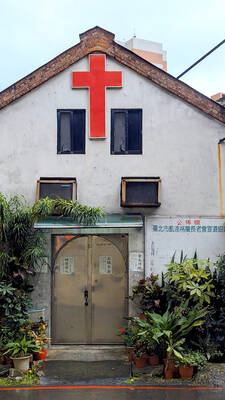Django Reinhardt is not a household name in popular music, but the late Belgian-born gypsy guitarist is often cited as a hero by a long list of “guitar gods” today, from Eric Clapton and Jimmy Page to Carlos Santana and BB King.
During the 1930s and 1940s, Reinhardt led the legendary Parisian group the Quintet of the Hot Club of France, and by the time of his death in 1953, he was already considered a pioneer of jazz guitar.
Reinhardt, whose style is instantly recognizable for its lightning quick riffs and emotive playing, remains the inspiration behind what is known today as gypsy jazz. Today, he is regarded as a deity among gypsy guitar players and his music continues to command a large number of devotees around the world, including Canadian guitarist Denis Chang.

Photo: Benjamin Wong, Courtesy of Denis Chang
The 29-year-old Montreal native, who performs on Thursday and Friday next week in Taipei with the local group Dark Eyes Gypsy Jazz Band, is regarded as an established talent in gypsy jazz circles.
Since 2003, Chang has been shuttling back and forth between Canada and Europe, attending festivals devoted to the genre and studying with well-known gypsy players such as Fapy Lafertin of Belgium and Ritary Gaguenetti of France. He has also shared the stage with other acclaimed musicians such as French virtuoso Stephane Wrembel and the Dutch gypsy group the Rosenberg Trio.
Chang has a degree in music from McGill University, but says his most valuable lessons as a performer came from befriending gypsy players in Europe.
“I did go to music school, but as far as playing music goes, that didn’t help me,” Chang said. “What really helped me a lot was just hanging out with these guys because a lot of these people there, they don’t know anything about formal training or music theory.”
INSTINCT
Yet gypsy jazz requires a high degree of technical skill, with long melodic lines played at dizzying speeds and “hot,” fast-pulsing rhythms.
In this sense, Chang said that gypsy jazz is “a very strong aural tradition that really focuses on playing by ear and playing by instinct. And that was the biggest lesson for me.”
Chang also discovered he had a knack for teaching. He says he has been able to establish a close rapport with European gypsy players because he is fluent in French and German. He drew from that experience and produced a set of instructional DVDs titled Jazz Manouche that is popular among gypsy jazz enthusiasts.
Although he works full-time as a performer and producer, Chang says his interests are starting to shift to music education, and he is getting ready to launch a Web site devoted to teaching different styles of music.
LEARNING THE ROPES
He attributes this “lifelong passion” for education, as well as his language skills, to his late Taiwanese father, Chang Wei-penn (張維邦), a well-known independence activist and scholar of economics and European studies.
Chang will also be teaching a workshop for guitarists interested in learning gypsy jazz on Dec. 18 at the National Taiwan University Student Activity Center No. 2 (臺灣大學第二學生活動中心).
With gypsy jazz, “there’s something for everyone,” said Chang, who notes the genre attracts some heavy metal guitarists because it’s “full of energy” and allows for displays of technical virtuosity.
“So the heavy metal guys are happy, and it borrows a lot from classical music, because Django was heavily influenced by classical music,” he said.
But at the end of the day, gypsy jazz does what jazz is supposed to do: It swings.
“[It’s] music that makes you want to dance, makes you want to tap your toes,” Chang said. “It’s joyous, it’s happy.”

The Directorate-General of Budget, Accounting and Statistics (DGBAS) told legislators last week that because the Chinese Nationalist Party (KMT) and Taiwan People’s Party (TPP) are continuing to block next year’s budget from passing, the nation could lose 1.5 percent of its GDP growth next year. According to the DGBAS report, officials presented to the legislature, the 2026 budget proposal includes NT$299.2 billion in funding for new projects and funding increases for various government functions. This funding only becomes available when the legislature approves it. The DGBAS estimates that every NT$10 billion in government money not spent shaves 0.05 percent off

It is a soulful folk song, filled with feeling and history: A love-stricken young man tells God about his hopes and dreams of happiness. Generations of Uighurs, the Turkic ethnic minority in China’s Xinjiang region, have played it at parties and weddings. But today, if they download it, play it or share it online, they risk ending up in prison. Besh pede, a popular Uighur folk ballad, is among dozens of Uighur-language songs that have been deemed “problematic” by Xinjiang authorities, according to a recording of a meeting held by police and other local officials in the historic city of Kashgar in

Dec. 29 to Jan. 4 Like the Taoist Baode Temple (保德宮) featured in last week’s column, there’s little at first glance to suggest that Taipei’s Independence Presbyterian Church in Xinbeitou (自立長老會新北投教會) has Indigenous roots. One hint is a small sign on the facade reading “Ketagalan Presbyterian Mission Association” — Ketagalan being an collective term for the Pingpu (plains Indigenous) groups who once inhabited much of northern Taiwan. Inside, a display on the back wall introduces the congregation’s founder Pan Shui-tu (潘水土), a member of the Pingpu settlement of Kipatauw, and provides information about the Ketagalan and their early involvement with Christianity. Most

The People’s Republic of China (PRC) was out in force in the Taiwan Strait this week, threatening Taiwan with live-fire exercises, aircraft incursions and tedious claims to ownership. The reaction to the PRC’s blockade and decapitation strike exercises offer numerous lessons, if only we are willing to be taught. Reading the commentary on PRC behavior is like reading Bible interpretation across a range of Christian denominations: the text is recast to mean what the interpreter wants it to mean. Many PRC believers contended that the drills, obviously scheduled in advance, were aimed at the recent arms offer to Taiwan by the